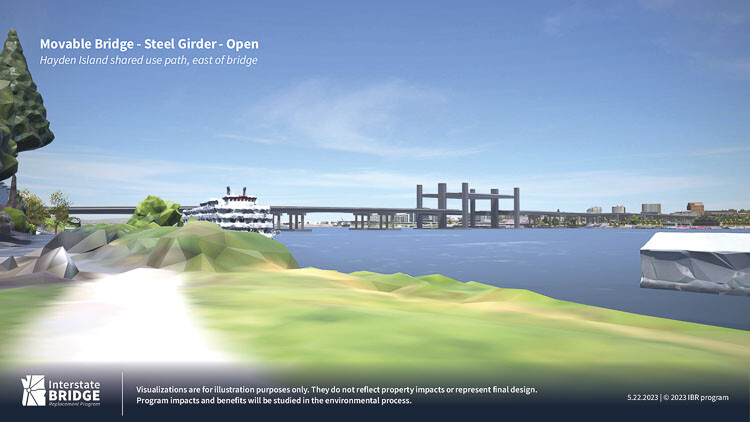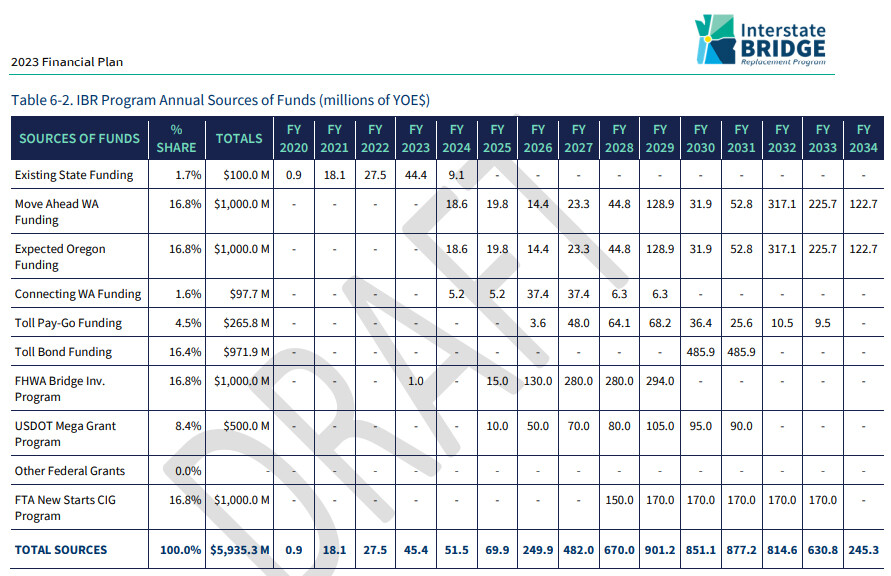Oregon legislature will likely not provide $1 billion this session
John Ley
For Clark County Today
The Interstate Bridge Replacement (IBR) project, as of early June 2023, is a mixed picture of success and challenges ahead. It’s been three and a half years since the two state governors restarted the process. Citizens got their first look at possible “visualizations” of the bridge options last week. Two community forums have been held.
The program successes are getting the Washington legislature to allocate $1.1 billion towards the IBR. A total of $100 million was allocated in the 2015 Connecting Washington gas tax package of projects; and $1 billion allocated in the 2022 Move Ahead Washington package.
A second success has been approval from all the various groups associated with the IBR, to have light rail as the transit component of the project, as opposed to Bus Rapid Transit (BRT) or no “high capacity” transit option. C-TRAN CEO Shawn Donaghy recently told Clark County Today the Federal Transit Administration (FTA) supports BRT “because they typically cost less and provide more flexibility compared to other modes”.The FTA understands light rail is the preferred transit component of the IBR.

A third initial success is getting the federal government and President Biden to agree the IBR is a project of “national significance,” and it is specifically mentioned in the $1.2 trillion IIJA (Infrastructure Investment and Jobs Act). However other national projects have been funded ahead of the IBR as they await a “contribution” from Oregon.
Current challenges for the IBR are many. At the top of the list – Oregon is facing huge obstacles in providing its $1 billion in funding the project. States must provide the “local” funding prior to the federal government committing funds. Oregon Gov. Tina Kotek rejected an initial proposal from some legislators who wanted to bond against future general fund revenues for the next decade.
An additional significant problem is the Oregon Senate does not have a quorum to pass any legislation. Over 10 Republican and one independent senators have walked out preventing the ability of the Democrat majority to pass any legislation in the Senate. The current session ends June 25. Republicans have said they will come back on June 25, presumably to pass a budget to keep the Oregon government running. But it is problematic that they would be able to reach an agreement on a transportation package.
The March 2023 Oregon Transportation Plan (OTP) indicates the state has a huge backlog of work just to maintain their current system of roads and bridges. This is in addition to a roughly $2 billion funding shortfall for current projects, including the I-5 Rose Quarter and I-205 Abernethy Bridge projects.
“Under current funding levels, System Preservation and Adaptation investments fall further behind in addressing the needs of the current system”, the OTP reported. It also states: “nearly 300 bridges are likely to be weight restricted, with a $7 billion backlog in bridge maintenance and $4 billion backlog in pavement preservation.”
A second significant obstacle relates to tolling. Oregonians, and particularly Clackamas County residents are outraged at ODOT’s plan to toll I-205. There will be double tolls – one for crossing the Abernethy Bridge and then the Tualatin River bridge on I-205; plus an additional “per mile” toll for driving a significant length of I-205 as part of their Regional Mobility Pricing Program (MPP).
The tolling will cause significant traffic diversion onto side roads that are already congested with vehicles due to an overall lack of vehicle capacity in the region. Every community along the southeast part of I-205 is against the tolling because of the impact of traffic diversion. In many cases, tens of thousands of additional vehicle trips will congest side roads and arterials in Oregon City, Gladstone, West Linn, Canby, Tualatin, and Lake Oswego.
Numerous Oregon legislators have introduced legislation prohibiting tolling on I-205. Governor Kotek issued an Executive Order prohibiting ODOT from placing tolls on I-205 until January 2026, an estimated 18-month delay. This reduces the availability of “preconstruction” funds available for the Abernethy Bridge and I-205 expansion project.

At the June Regional Transportation Council (RTC) Board meetings, WSDOT’s Carly Francis told the board the Oregon governor’s order was only a “pause on toll collection”. The back office development by the IBR team continues.to including tolling. The IBR toll collection is planned for mid 2026 according to Francis.
Additionally, citizens have introduced IP-4 which will require a vote before a toll can be placed on any Oregon highway or freeway. This includes the Interstate Bridge. (Oregon currently has one of 17 exemptions to federal law which prohibits tolling on interstate freeways). The supporters of IP-4 need 200,000 signatures of registered Oregon voters in order to put the initiative on the November 2024 ballot.
If IP-4 becomes law, it eliminates potentially $1.24 billion in money the IBR hopes to borrow for the project, paid back by tolling revenues.
A third major obstacle for the IBR is the US Coast Guard and Army Corps of Engineers. They must grant approval of the project. At present, the Coast Guard has rejected an IBR request for a bridge with 116 feet of clearance for marine traffic. In the spring of 2022, it demanded any project provide at least the current 178 feet of clearance. In 2023, they reemphasized that demand and said they prefer a project with “unlimited” clearance for Columbia River marine traffic.
At the RTC meeting, Councilor Gary Medivy (RTC Board Chair) asked for an explanation, as the Coast Guard wants higher and the IBR “didn’t deliver.” Francis answered saying there was a “preliminary analysis” done and the conversation continues with upriver firms to see “if they can manage their needs over time” to accept a lower bridge. Medvigy noted that the previous effort required a significant payment to these firms.
The IBR is presently hoping to negotiate with river users, hoping to find a way to “mitigate” their opposition to the current proposal, which the Coast Guard might approve. In the failed Columbia River Crossing (CRC), the project was going to pay three upriver firms $86.4 million. That figure would be in excess of $114 million today. The IBR has demanded the firms sign non-disclosure agreements to keep current discussions secret.
The Nov. 2022 IBR Bridge Clearance Assessment Report indicates a 116 foot bridge with a movable span would require (at present) 85 openings per year.
Construction and tolling would begin in 2026, provided Oregon provides funding, the Federal Highway Administration provides an estimated $1.5 billion in funding for the roads and the bridges; and the FTA provides nearly $1 billion for light rail. But the biggest obstacle may be the Coast Guard and Army Corps of Engineers.
Also read:
- Opinion: Hiding the growing cost of the Interstate Bridge replacementJoe Cortright of the City Observatory addresses the rising cost of the Interstate 5 Bridge replacement project.
- 90 minutes of delay on Southbound I-5 in Southwest Washington on Friday afternoon, July 26Travelers using southbound Interstate 5 through Woodland should expect up to 90 minutes of delay during Friday afternoon and evening and should delay travel or prepare for additional travel time.
- Nighttime paving work on I-5 and SR 14 in Clark County July 28-Aug. 9Nighttime travelers in Clark County should expect delays for maintenance and paving work beginning Sunday, July 28 until the morning of Friday, Aug. 9.
- Northeast 182nd Avenue/Northeast Ward Road to be closed on Aug. 1Northeast 182nd Avenue and Northeast 172nd Avenue in Clark County will have single-day closures on August 1 and August 5 for road preservation, with detours in place.
- Interstate Bridge Replacement program awarded $1.499 billion FHWA Bridge Investment Program grantInterstate Bridge Replacement program officials have shared that the program received $1.499 billion through the Federal Highway Administration’s Bridge Investment Program.









